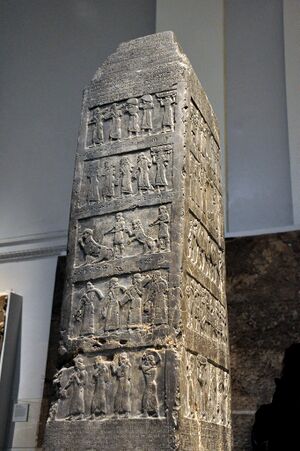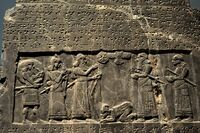المسلة السوداء لشلمنصر الثالث
| مسلة شلمنصر الثالث السوداء Black Obelisk of Shalmaneser III | |
|---|---|
 المسلة السوداء لـشلمنصر الثالث في المتحف البريطاني | |
| الخامة | حجري جيري أسود |
| الحجم | ارتفاع: حوالي 1.98 متر، عرض: 45 سم |
| الكتابة | الأكدية |
| أنشئت | 858-824 ق.م. |
| أُكتشفت | نمرود، العراق 36°05′53″N 43°19′44″E / 36.09806°N 43.32889°E |
| الموقع الحالي | المتحف البريطاني، لندن |
| التسجيل | ME 118885 |
موقع الاكتشاف | |
المسلة السوداء لشلمنصر الثالث is a black limestone Assyrian sculpture with many scenes in bas-relief and inscriptions. It comes from Nimrud (ancient Kalhu), in northern Iraq, and commemorates the deeds of King Shalmaneser III (reigned 858-824 BC). It is on display at the British Museum in London, and several other museums have cast replicas.
It is the most complete Assyrian obelisk yet discovered, and is historically significant because it is thought to display the earliest ancient depiction of a biblical figure - Jehu, King of Israel. The traditional identification of "Yaw" as Jehu has been questioned by some scholars, who proposed that the inscription refers to another king, Jehoram of Israel.[1][2] Its reference to 'Parsua' is also the first known reference to the Persians.
Tribute offerings are shown being brought from identifiable regions and peoples. It was erected as a public monument in 825 BC at a time of civil war، في الميدان الرئيسي لنمرود، بالقرب من المسلة البيضاء لآشور ناصر پال الأول الأقدم كثيراً. وقد اكتشفها الأثري السير أوستن هنري لايارد في 1846 وتوجد الآن في المتحف البريطاني.
الوصف
It features twenty relief scenes, five on each side. They depict five different subdued kings, bringing tribute and prostrating before the Assyrian king. From top to bottom they are: (1) Sua of Gilzanu (in north-west Iran), (2) "Jehu of Bit Omri" (Jehu of the House of Omri), (3) an unnamed ruler of Musri (probably Egypt), (4) Marduk-apil-usur of Suhi (middle Euphrates, Syria and Iraq), and (5) Qalparunda of Patin (Antakya region of Turkey). Each scene occupies four panels around the monument and is described by a كتابة مسمارية فوقهم.
On the top and the bottom of the reliefs there is a long cuneiform inscription recording the annals of Shalmaneser III. It lists the military campaigns which the king and his commander-in-chief headed every year, until the thirty-first year of reign. Some features might suggest that the work had been commissioned by the commander-in-chief, Dayyan-Assur.
السجل الثاني

The second register from the top is thought to include the earliest surviving picture of a biblical figure. The name appears as mIa-ú-a mar mHu-um-ri-i. Rawlinson's original translation in 1850 seminal work "On the Inscriptions of Assyria and Babylonia" stated: "The second line of offerings are said to have been sent by Yahua, son of Hubiri, a prince of whom there is no mention in the annals, and of whose native country, therefore, I am ignorant"[5][6] Over a year later, a connection with the bible was made by Reverend Edward Hincks, who wrote in his diary on 21 August 1851: "Thought of an identification of one of the obelisk captives — with Jehu, king of Israel, and satisfying myself on the point wrote a letter to the Athenaeum announcing it".[7] Hincks' letter was published by Athenaeum on the same day, entitled "Nimrud Obelisk".[8] Hincks' identification is now the commonly held position by biblical archaeologists.
The identification of "Yaw" as Jehu was questioned by contemporary scholars such as George Smith[9] as well as in more recent times by P. Kyle McCarter and Edwin R. Thiele,[1][2] based on the fact that Jehu was not an Omride, as well as transliteration and chronology issues. However, the name read as "Yaw, son of Omri (Bit-Khumri", see House of Omri), is generally accepted to follow Hincks as the Biblical Jehu, king of Israel.
The stele describes how Jehu brought or sent his tribute in or around 841 BC.[10] Jehu severed Israel’s alliances with Phoenicia and Judah, and became subject to Assyria. The caption above the scene, written in Assyrian cuneiform, can be translated:
“I received the tribute of Iaua (Jehu) son of (the people of the land of) Omri (آكادية: 𒅀𒌑𒀀 𒈥 𒄷𒌝𒊑𒄿): silver, gold, a golden bowl, a golden vase with pointed bottom, golden tumblers, golden buckets, tin, a staff for a king [and] spears."[4]
Part of the gift-bearing Israelite delegation of King Jehu, Black Obelisk, 841-840 BCE.[12]
Jehu on the Black Obelisk of Shalmaneser III.[13] This is "the only portrayal we have in ancient Near Eastern art of an Israelite or Judaean monarch".[4]
نسخ طبق الأصل
يمكن مشاهدة نسخ طبق الأصل في المعهد الشرقي في شيكاغو، إلينوي وفي المتحف السامي بجامعة هارڤرد في كمبردج، مساتشوستس, at the ICOR Library in the Semitic Department at The Catholic University of America, in Washington, District of Columbia, in Salem, Oregon, at Corban University's Prewitt/Allen Archaeological Museum, at the Siegfried H. Horn Museum at Andrews University in Berrien Springs, MI and in the library of the Theological University of the Reformed Churches in Kampen, the Netherlands.

انظر أيضاً
الهامش
- ^ أ ب P. Kyle McCarter, Bulletin of the American Schools of Oriental Research, No. 216 (Dec., 1974), pp. 5-7
- ^ أ ب Edwin R. Thiele, Bulletin of the American Schools of Oriental Research, No. 222 (Apr., 1976), pp. 19-23
- ^ Kuan, Jeffrey Kah-Jin (2016). Neo-Assyrian Historical Inscriptions and Syria-Palestine: Israelite/Judean-Tyrian-Damascene Political and Commercial Relations in the Ninth-Eighth Centuries BCE (in الإنجليزية). Wipf and Stock Publishers. pp. 64–66. ISBN 978-1-4982-8143-0.
- ^ أ ب ت Cohen, Ada; Kangas, Steven E. (2010). Assyrian Reliefs from the Palace of Ashurnasirpal II: A Cultural Biography (in الإنجليزية). UPNE. p. 127. ISBN 978-1-58465-817-7.
- ^ On the Inscriptions of Assyria and Babylonia, 1850
- ^ The Bible in the British Museum: Interpreting the Evidence, T. C. Mitchell, page 14
- ^ Studies on the Text and Versions of the Hebrew Bible in Honour of Robert Gordon, edited by Geoffrey Khan, Diana Lipton, p159
- ^ "Nimrud Obelisk, Athenaeum, 1251, 1384-85
- ^ Assyrian Eponym Canon, George Smith, 1875, page 190, "There is another supposed Hebrew king in the annals of Shalmaneser, b.c. 842, Extracts VIII. and X., called "Jehu son of Omri," who is generally identified with "Jehu son of Nimshi," the king of Israel. The country ruled by Jehu, son of Omri, is not stated in the inscriptions; and it appears unlikely that Jehu, king of Israel, who exterminated the family of Omri, should call himself son of that king. Without advancing any theory for the identification of the monarch mentioned in the Assyrian inscriptions, I would urge that the identity of the Jehu of the Bible with the Jehu of the inscriptions is not proved, and that these notices are not enough to force us to alter all our Bible dates."
- ^ Millard, Alan (1997) Discoveries from Bible Times, Oxford, Lion, p121
- ^ Delitzsch, Friedrich; McCormack, Joseph; Carruth, William Herbert; Robinson, Lydia Gillingham (1906). Babel and Bible;. Chicago, The Open court publishing company. p. 78.
- ^ Delitzsch, Friedrich; McCormack, Joseph; Carruth, William Herbert; Robinson, Lydia Gillingham (1906). Babel and Bible;. Chicago, The Open court publishing company. p. 78.
- ^ Kuan, Jeffrey Kah-Jin (2016). Neo-Assyrian Historical Inscriptions and Syria-Palestine: Israelite/Judean-Tyrian-Damascene Political and Commercial Relations in the Ninth-Eighth Centuries BCE (in الإنجليزية). Wipf and Stock Publishers. pp. 64–66. ISBN 978-1-4982-8143-0.
- ^ Delitzsch, Friedrich; McCormack, Joseph; Carruth, William Herbert; Robinson, Lydia Gillingham (1906). Babel and Bible;. Chicago, The Open court publishing company. p. 78.


![The four illustrated faces of the Black Obelisk. The second row of reliefs illustrates the Israelite delegation of King Jehu.[11]](/w/images/thumb/3/31/Black_Obelisk%2C_four_faces.jpg/200px-Black_Obelisk%2C_four_faces.jpg)

![Part of the gift-bearing Israelite delegation of King Jehu, Black Obelisk, 841-840 BCE.[12]](/w/images/thumb/d/d4/Black_Obelisk_side_4_Jewish_delegation.jpg/200px-Black_Obelisk_side_4_Jewish_delegation.jpg)
![Jehu on the Black Obelisk of Shalmaneser III.[13] This is "the only portrayal we have in ancient Near Eastern art of an Israelite or Judaean monarch".[4]](/w/images/thumb/3/39/Jehu_on_the_Black_Obelisk_of_Shalmaneser_III.jpg/171px-Jehu_on_the_Black_Obelisk_of_Shalmaneser_III.jpg)
